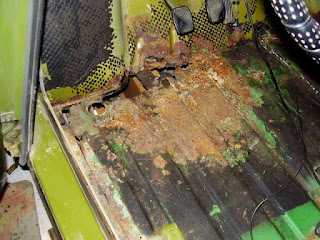Saab V4 distributors have a lot of parts inside, as the exploded view drawing shows. Not only do these parts send spark to the correct spark plug at the correct time, they allow the spark to be advanced according to the needs of the engine. This means the engine will run SMOOTH, man! The boxed drawing shows the complete, assembled distributor with cap and wires. 
The springs and weights provide the MECHANICAL advance. The vacuum diaphragm provides the VACUUM advance.

This is a typical used distributor as we receive it for rebuilding. SLIMEY! YUK! But part of the yuk is black paint, part is grease and grime. 1698cc Ford V4 engines were painted BLACK, and so were the distributors for those engines. Paint flakes off, crud goes one---makes 'em look UGLY!

Bosch distributors for the V4 Saab cars had no bushing at the drive end, so the center shaft runs in the aluminum case, which "hogs out" to a larger hole. That makes for a sloppy cam at the top, which lets the point gap vary all over the place. As point gap varies, DWELL varies, and ignition TIMING varies. The result? The spark plugs fire at the wrong time, and the engine is NOT happy about it. Here I am using my lathe, boring the distributor for a bushing.

Here's how I setup the lathe for boring the drive end of the distributor for a bushing. I use a special tool to mount the distributor body so it is exactly centered in the lathe for the boring job. It's nice to have the right tool for the job!

I use a special driver to press the bushing into the distributor body. Then I ream the bushing to give the correct clearance for the distributor main shaft.

AHA! The distributor body and new vacuum advance unit. They look better without the SLIME. The reassembly and testing are next. That's when the FUN begins!

I use the SUN distributor test machine to set the mechanical advance curve. I tailor the curve for the projected USE of the engine. For example, professional RACE engines get a different curve than your street engine because they are run consistently from 6-8,000 rpm.
If your engine has over 70,000 miles and you've noticed it doesn't run or idle like it used to, it's likely that your distributor is tired and ready for an overhaul.
Your engine will run much smoother, accelerate better, have better gas mileage.
You'll find it's money well spent!















































